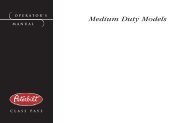Peterbilt Model 320 Operator's Manual after 8-07 - Peterbilt Motors ...
Peterbilt Model 320 Operator's Manual after 8-07 - Peterbilt Motors ...
Peterbilt Model 320 Operator's Manual after 8-07 - Peterbilt Motors ...
Create successful ePaper yourself
Turn your PDF publications into a flip-book with our unique Google optimized e-Paper software.
Operating the Clutch<br />
service department perform any adjustments necessary.<br />
Do not adjust your clutch by adjusting the external linkage<br />
without first checking (and correcting if necessary) the<br />
internal clutch adjustment. Using only the external linkage<br />
adjustment could damage the clutch.<br />
Clutch Brake<br />
Your clutch brake is used for stopping gear rotation to let<br />
you shift into 1st gear or reverse when your vehicle is at a<br />
standstill.<br />
About the last 1/2 to 1 inch of clutch pedal travel activates<br />
your clutch brake. So if you are stopped and want to shift<br />
directly into 1st or reverse, depress the clutch pedal until<br />
contact with the clutch brake is made to stop transmission<br />
gear rotation.<br />
If you have a butt-tooth condition and can’t shift the transmission,<br />
gradually release the clutch. Then the drive gear<br />
can roll enough to allow the teeth to line up properly and<br />
complete the shift.<br />
PART 7: STARTING & OPERATING THE VEHICLE<br />
CAUTION: Be careful not to apply the clutch<br />
brake while the vehicle is moving. The purpose<br />
of the clutch brake is to stop the transmission<br />
so that you can shift into a starting gear without<br />
grinding. Applying the clutch brake when<br />
the vehicle is moving causes a braking effect<br />
on the entire vehicle. This wear naturally shortens<br />
the service life of your clutch brake.<br />
Double Clutching<br />
Whether you are upshifting or down shifting, it is best to<br />
double clutch. Double clutching is easier on your transmission<br />
and on your engine, helping your vehicle match engine<br />
speed with driveline speed and achieving clash free shifts.<br />
To double clutch:<br />
1. Push down the clutch pedal to disengage the clutch.<br />
2. Move the gear shift lever to neutral.<br />
3. Release the pedal to engage the clutch. This lets you<br />
control the RPM of the mainshaft gears. Thus you can<br />
match the RPM of the mainshaft gears to those of the<br />
output shaft.<br />
Upshifts- Let the engine and gears slowdown to the<br />
RPM required for the next gear. Use the tachometer<br />
to determine optimum RPM for gear engagement.<br />
Downshifts- Press accelerator to increase engine and<br />
gear speed to the RPM required in the lower gear. Use<br />
the tachometer to determine optimum RPM for gear<br />
engagement.<br />
– 80 – Y53-6015 R(08/<strong>07</strong>)
















